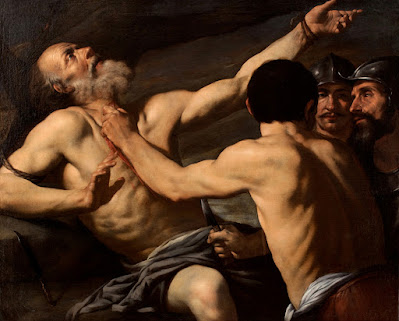 |
| Jean-Baptiste-Henri Deshays Martyrdom of a Saint before 1765 drawing Musée du Louvre |
 |
| Charles Le Brun Figure Studies ca. 1686 drawing (studies for thesis frontispiece) Musée du Louvre |
 |
| Michelangelo Buonarroti Study of Wrestlers before 1564 drawing Musée du Louvre |
 |
| Jacob Jordaens Christ driving the Money-changers from the Temple ca. 1650 drawing, with watercolor (study for painting) Musée du Louvre |
 |
| Willem van Mieris Massacre of the Innocents before 1747 drawing on vellum Metropolitan Museum of Art, New York |
 |
| Andrea Vaccaro Martyrdom of St Bartholomew before 1670 oil on canvas private collection |
 |
| attributed to Antonio Zanchi Soldier abducting a Woman ca. 1690-1710 oil on canvas Northampton Museum and Art Gallery, Northamptonshire |
 |
| Jean-Honoré Fragonard Boreas abducting Orithyia ca. 1780 drawing Musée du Louvre |
 |
| Augustin Pajou Warrior abducting a Woman ca. 1752-56 drawing Princeton University Art Museum |
 |
| Carlo Urbino Study for Temptation of St Anthony before 1585 drawing Musée du Louvre |
 |
| Giovanni Francesco Romanelli Sultan prevented from slaying his daughter Zahide (scene from an epic poem by Pierre Le Moyne) before 1662 drawing Musée du Louvre |
 |
| attributed to Pordenone (Giovanni Antonio Licinio) David and Goliath before 1539 drawing Musée du Louvre |
 |
| attributed to Giuseppe Passeri Battle Scene with King slaying Himself before 1714 drawing Musée du Louvre |
 |
| Giovanni Lanfranco Martyrdom of St Bartholomew ca. 1638-44 drawing (study for fresco) Musée du Louvre |
 |
| Ferraù Fenzoni Salome receiving the Head of John the Baptist before 1645 oil on canvas private collection |
 |
| Alexandre-Isidore Leroy de Barde Tiger strangled by a Serpent before 1828 watercolor and gouache on paper Musée du Louvre |
"So many Learned Men have Treated of the Passions, that it is hardly possible to say any thing which they have not already written thereupon: And I should not take the pains to Report their Opinion in the Matter, if it were not the better to make you comprehend that which concerns our Art. It seems therefore necessary, that I should touch something upon it, in favour of the young Students in Painting, which I shall endeavour to do with the greatest Brevity I can. . . . Passion is a Motion of the Soul, residing in the Sensitive Part thereof, which makes it pursue that which the Soul thinks for its good, or avoid that which it thinks hurtful to it. And for the most part, whatsoever causes Passion in the Soul, makes some Action in the Body. . . . Action is nothing but the Motion of some part; and this Alteration cannot be, but by an alteration of the Muscles, and they have no Motion, but by the extremities of the Nerves which pass through them: The Nerves do not Act but by the Spirits which are contained in the Cavities of the Brain; and the Brain receives the Spirits from the Blood, which passing continually through the Heart, is thereby heated and rarefied in such manner, that it produces a certain subtil Air or Spirit, which ascends up to, and fills the Brain. The Brain thus filled, sends back these Spirits to the other parts, by the Nerves, which are as so many small Channels, or Pipes, that convey the Spirits into the Muscles, more or less, according as the Action requires, in which they are employed. So as that Muscle which is most in Action, receives the greatest quantities of Spirits, and consequently becomes more swell'd than the others, which are thereof depriv'd, and by such privation seem more loose and more wasted or shrunk than the others. . . . But in Anger, all the Motions are very great and violent, and all the Parts agitated; the Muscles should be very apparent, bigger and more swelled than ordinary, and the Veins and Nerves strained."
– Charles Le Brun, from Conference on Expression (1668), translated by John Smith (1701)